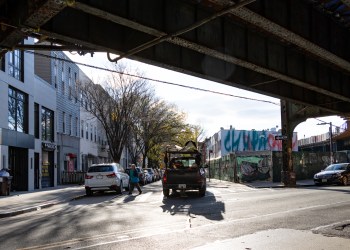Light Rain Doesn't End Drought Watch or Brush Fire Risk
The shower dropped less than a quarter of an inch of rain, and the city is heading into another dry week.

A brush fire broke out in Prospect Park on Friday night amid drought conditions in New York City. Photo via Michelle Paggi, Ph.D./via REUTERS
A little fall of rain on Sunday wasn’t enough to end the drought in New York City, though conditions in Brooklyn have improved slightly since a brush fire broke out in Prospect Park on Friday.
The city saw its first measurable rainfall since September on November 10, but the shower dropped less than a quarter of an inch of rain, and the city is heading into another dry week, according to the National Weather Service New York. Mayor Eric Adams last week issued a citywide drought watch after a historically dry October, urging New Yorkers to voluntarily conserve water and ordering city agencies to start making plans for a longer-term drought.
On November 9, the day after a two-alarm fire burned through two acres in Prospect Park, the mayor banned grilling in city parks for the foreseeable future. Very dry conditions could mean that embers or even lit cigarette butts, which might usually burn out on their own, can instead start fires if they land in dry leaves or other vegetation. The same night as the fire in Brooklyn’s Backyard, small brush fires broke out in Marine Park and Gerritsen Beach.

“Effective immediately, we are prohibiting grilling in our parks, and we need all New Yorkers to take commonsense steps to prevent brush fires,” Adams said in a statement. “Getting through this drought will take all of us working together, and every drop counts, so let’s keep doing our part to save as much water as we can.”
Officials also urged New Yorkers to stay on the paths while walking, be mindful of their cigarette butts, and take care to clear dry leaves from sidewalks near their homes and businesses. Prospect Park was reopened to visitors on Saturday, the day after the fire, but the Prospect Park Alliance urged parkgoers to use caution as the group and parks officials worked to determine the extent of fire damage.
While the Prospect Park fire was contained within a few hours and left only one person injured, fires are still burning elsewhere in the New York Metropolitan Area. A fire has spread across 3,000 acres in northern New Jersey and in Orange County, New York, according to the New Jersey Forest Fire Service, while other fires that had been burning on the Palisades cliffs and elsewhere in New Jersey were contained over the weekend.
Smoke from those fires wafted over New York City last weekend and sent air quality plummeting to unhealthy levels. As of Monday morning, air quality in Brooklyn had returned to normal, and was considered “Good,” per AirNow, though that could change depending on fire and wind conditions.
Drought conditions continue
The city is still particularly dry, though. Less than a quarter-inch of rain fell on New York City on Sunday night, according to the local National Weather Service, and didn’t have much impact on the dry conditions and drought, or on the fire still burning in Orange County.
New York City is in a “moderate drought,” per U.S. Drought Monitor, while much of the rest of the state is “abnormally dry.” The state’s Department of Environmental Conservation has issued a drought watch for the southern part of the state, from New York City up to Schoharie County. A drought watch is issued when a drought is developing, per the DEC website. Under a drought watch, all water conservation is voluntary. If dry conditions continue, and the watch is upgraded to a warning, voluntary water conservation would intensify, per the DEC, and local officials would begin to make contingency plans.
The watch is likely to be upgraded to a warning in coming weeks, according to Gothamist, since the forecast for New York City looks dry into December.

Mandatory water restrictions are not on the table until a “drought emergency.” New York City gets most of its drinking water from reservoirs upstate, and as of November 8, the reservoirs were at about 64% capacity, according to the New York City Department of Environmental Protection. Normally, at this time of year, the reservoirs would be at about 79.1%.
“This fall’s historic drought and unseasonably warm temperatures are showing us risks of climate change that New Yorkers are not used to seeing, but that we’re well-prepared and well-equipped to confront,” said New York City Chief Climate Officer and DEP Commissioner Rohit T. Aggarwala, in a statement. “Whether it’s helping agencies and individuals conserve water, improving our leak detection efforts, or helping to fight upstate wildfires that pose a threat to our water supply, DEP is laser-focused on managing this drought on multiple fronts. All New Yorkers can help; the added pressure on our water supply introduced by wildfires makes it even more critical that every New Yorker takes concrete steps to reduce their water consumption and help stop preventable fires.”
Editor’s note: A version of this story originally ran in Brooklyn Paper. Click here to see the original story.
Related Stories
- Climate Report Predicts NYC’s Future Will Include Extreme Heat and Rain
- Climate Change and Warmer Winters Mean More Rain and Flooding in Brooklyn
- Porous Pavement Coming to Some Brooklyn Streets in Flood Prevention Test
Email tips@brownstoner.com with further comments, questions or tips. Follow Brownstoner on X and Instagram, and like us on Facebook.









What's Your Take? Leave a Comment